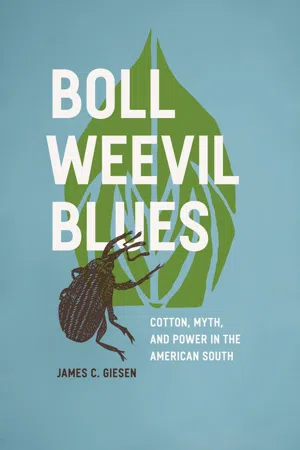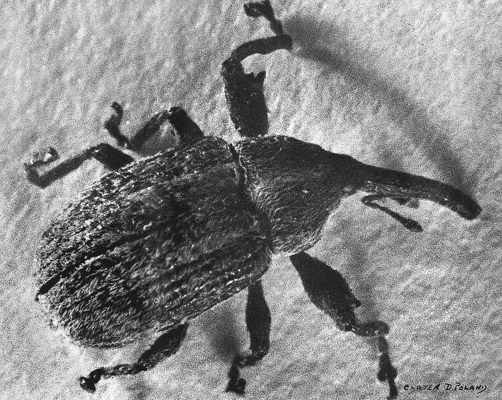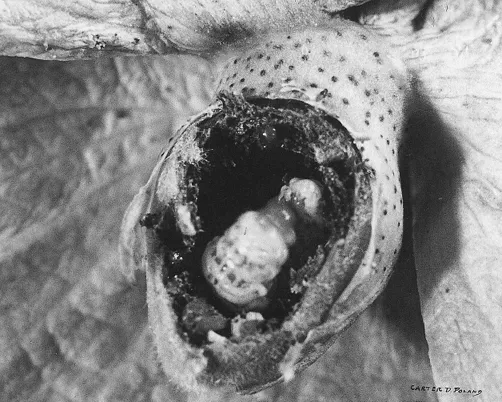![]()
CHAPTER 1
Myth Making on the Cotton Frontier
In early 1903, farmers in Terrell, Texas, were nervous about the slowly spreading boll weevil. The town’s business leaders called a meeting of the area’s most influential farmers and invited famed agricultural educator and USDA special field agent Seaman Knapp to address them. The old professor later claimed that he was there to allay farmers’ fear of the encroaching pest, to put at ease a community demoralized by the prospect of the boll weevil’s arrival. But his practical advice for farmers could not counter their hysteria. According to Knapp, when he concluded his remarks, a man sitting in the back of the room rose to his feet and “stated that it was impossible to fight the weevil.” The pest “was proof against everything that had been tried,” the farmer claimed. The man explained that only a few days earlier, he had captured a few live weevils and put them in a jar of “ninety-five per cent pure alcohol.” Four hours later he poured out the jar and the bugs emerged alive, “only staggering drunk.” Dumbfounded, the farmer collected the inebriated insects, “sealed them in a tin can, threw them into a brush heap and set it on fire.” A few minutes later, he watched as “the solder melted and the red-hot weevils flew out and set the barn on fire.” Knapp knew that in this apocryphal story lay an important truth: the boll weevil had caught the attention of Texas farmers like nothing else ever had. In this bug, and more precisely in people’s fear of it, Knapp recognized, was contained the power to transform southern agriculture forever.1
By 1903, the boll weevil had been present in Texas for at least ten years, but mythical stories of the pest’s formidable strength and assured destruction of cotton life were everywhere. As Knapp traveled east Texas that year, he talked to farmers, bankers, and merchants about the boll weevil’s advance and surveyed the pest’s impact on rural life firsthand. Later he recalled, “I saw hundreds of farms lying out; I saw a wretched people facing starvation; I saw whole towns deserted; I saw hundreds of farmers walk up and draw government rations, which were given to them to keep them from want.” According to Knapp, the boll weevil had destroyed the cotton way of life in Texas.2
But had it? There can be no doubt that the boll weevil hit Texas hard in the late nineteenth and early twentieth centuries. It destroyed thousands of tons of cotton. The pest disrupted the lives of tenant farmers and landowners, hurt railroads, merchants, and banks, and became the obsession of state politicians and scientists. However, interpretations like Knapp’s overplay the extent to which the pest affected the economic and social systems girding cotton-farming communities. In fact, Knapp and his colleagues came to realize soon after the pest’s identification in Texas that the boll weevil’s invasion presented an unmatched opportunity to rethink the agricultural systems of not only the Lone Star State, but of the entire South.
In spite of this evidence of the boll weevil’s destructiveness, cotton production actually increased in Texas during this period. Perhaps even more surprising, cotton growers barely altered their farming methods when the insect appeared. This seeming paradox of the destruction of Texas cotton and the persistence and extension of cotton production in the state suggests not simply a popular misunderstanding of the boll weevil’s history in the state; it points to the nascent development of a lasting myth about the pest and its effect on rural Texas.
The boll weevil myth born in Texas grew from the bona fide threat the pest posed to cotton culture. Landowners, tenant farmers, state and federal politicians, bureaucrats, and scientists understood the boll weevil threat differently, and offered their own interpretations of the bug’s meaning for the South, but it was federal officials like Knapp who had the most success shaping the myth and using it to build private and public support for their work. These state and federal employees saw in the pest a solution to the South’s overdependence on cotton and a way to overcome farmers’ unwillingness to employ modern, scientific farming methods. Most importantly, these farm educators and scientists knew the pest could foster relevance, even need for their institutions: the USDA, state agricultural departments, land grant colleges, and research farms. To be sure, these experts wanted to limit the destructiveness of the boll weevil, but they also sought a more central place in American farm life.
*
Long before the arrival of federal investigators, the boll weevil roamed the Texas borderlands unknown, or at least unrecognized. Before the cotton pest became the cause célèbre of southern reformers, it was a bug in a field that no one could identify. Farmers probably talked to one another about the pest; landowners surely asked their tenants about the little brown beetles. But on the diverse, ever-changing, chaotic borderlands of southern Texas in the late nineteenth century, there was already enough for farmers to worry about, as the pest was just another factor in the gamble that was cotton farming.
The Texas borderlands had long been home to speculators, drifters, and those in search of the safety provided by remoteness. Fifty years earlier, American slaves and Mexican peones sought the border as a place of refuge, but by the 1880s, the region was undergoing a radical restructuring at the hands of the cotton plant and its social, economic, and environmental impacts. The fleecy white crop had found a home in east Texas decades earlier, but as available land there became scarce and extant cotton land grew less productive, farmers pushed the crop to the west and south toward the Rio Grande. White, black, and Mexican workers from both sides of the border followed the plant into southern Texas to work these newly transformed fields. The arrival of cotton to the region not only brought changes in labor, economic, and social systems, it connected this plant—the most important cash crop grown in the United States—to the habitat of its fiercest predator. When Texans extended the Cotton Belt to the Rio Grande, they in essence made a connection between the boll weevil habitats of northern Mexico and coastal Texas into a two-thousand-mile cotton buffet stretching to the Atlantic Ocean.3
Though traditional accounts of the boll weevil’s arrival in the United States begin with the USDA’s formal identification of the insect in 1894, recent scientific literature suggests that the pest was present in Texas for decades earlier. The boll weevil’s principal plant host is commercial cotton (Gossypium hirsutum), but it can sustain itself, and in some cases thrive, on a small number of alternative plants. One of these potential hosts is a close relative of cotton, Cienfuegosia drummondii, which grows natively in only one area of the United States, the coastal region of south Texas near the Mexican border. The very place where the boll weevil first appeared in commercial cotton is, not coincidentally, home to the insect’s second most important host plant. In the nineteenth century, botanists and entomologists cared little about this flowering plant or the bugs that took their nourishment from it. In fact, no one seems to have identified it as a host for the boll weevil until the mid-twentieth century.4
But when does a pest become a pest? In the 1890s, Cienfuegosia drummondii escaped professional examination because it grew in an ecology removed from what most Texans or Mexicans understood as economically or socially important, yet the plant was within range of the migration routes of weevils living in Mexican cotton fields. As a result, the boll weevil was almost certainly present in south Texas long before area farmers noticed it destroying their commercial cotton crop. Even later, after Texans remade the grazing land that was nearer this alternative weevil habitat into cotton fields, the weevil certainly bothered farmers before they knew what it was. That the boll weevil was present in the American South earlier than southerners, as well as historians, have understood, reveals the privileged role that the government, and the USDA in particular, played in shaping the traditional narrative of the boll weevil’s effect on the Cotton Belt. That scholars have begun their stories with the government’s arrival in south Texas is evidence in itself of the success of the USDA and its related agencies to write the narrative of the boll weevil and to create its own image as a bulwark against this “revolutionary” natural enemy.5
It was not until 1894 that the insect came to the attention of an American outside of south Texas. That year Charles H. DeRyee, a druggist from Corpus Christi, sent a few dead specimens to the Commissioner of Agriculture in Washington, D.C. His accompanying letter advised that the “cotton in this section has been very much damaged and in some cases almost entirely destroyed by a peculiar weevil or bug which by some means destroys the squares and small bolls.” The message touched off a surprising amount of activity within the USDA. Leland O. Howard, official entomologist for the department, examined but could not identify the samples. He passed the specimens on to other experts both inside and outside the department. When several renowned American entomologists failed to identify the bug, the department finally sent a sample to Paris, France, where the entomologist August Salle identified the insect as Anthonomus grandis, the cotton boll weevil.6
Salle based his identification on the classification Swedish entomologist C.H. Boheman made fifty years earlier. In the mid-nineteenth century, Boheman had examined boll weevils collected near Vera Cruz, Mexico. He recorded few details about the weevil aside from its appearance. No one seems to have tracked the insect’s movement during the mid-nineteenth century until German entomologist Eduard Suffrian noted its presence in Cuba in the early 1870s. A decade later, British-born entomologist Edward Palmer, working for the USDA, traveled throughout Mexico and Central America observing insect life. He recorded the ravages of a “small, dark-colored weevil” near Monclova, Coahuila, Mexico, roughly 115 miles from the U.S. border. Palmer had written to the U.S. Commissioner of Agriculture to report that infestations of this pest had grown so extreme in parts of northern Mexico that farmers had abandoned cotton altogether. The USDA made no effort to follow up on Palmer’s research, however. The Mexican and American cotton districts were still unconnected at that point, and the entomological community knew nothing of the pest’s range of migration or the host plants available in south Texas. In the final two decades of the nineteenth century, Texans planted cotton closer and closer to the border, however, bringing the American cotton belt ever closer to Mexico and the boll weevil.7
After the USDA identified the weevil specimens sent from Texas, the organization began a remarkable period of activity. First, the department sent word back to Charles DeRyee, warning the Corpus Christi businessman of the “imminent danger that [the weevil] may spread into other portions of the cotton belt.” Second, with a quickness that indicates the USDA’s relatively small size and bureaucratic agility at the time, entomology chief Howard dispatched Tyler Townsend to south Texas to investigate the weevil damage. Townsend, a department entomologist stationed at Las Cruces, New Mexico, had recently returned from a trip to northern Mexico to research cotton pests.8
In November 1894, Townsend arrived in Eagle Pass, Texas, a border town southwest of San Antonio, and began talking to local farmers and examining weevil specimens. From Eagle Pass, he traveled east to Corpus Christi and Brownsville, where locals told him that the weevil had been present for at least a decade, and into northern Mexico, in hopes of finding a way that local farmers successfully combated the bug. Townsend remained in the region for a month, talking with landowners, measuring the decline in the cotton crop, and observing the life cycle and habits of the beetle. In December, he returned to New Mexico and prepared his report.9
Townsend based his initial recommendations on a close study of the physiology of both cotton and the boll weevil. It was clear to the entomologist that the combination of the weevil’s dependence on cotton and the manner in which it destroyed the plant made it a profound threat to future cotton cultivation anywhere the crop grew. Most important of the discoveries made by Townend, as well as scientists who have since investigated the pest, was the realization that the boll weevil’s entire life cycle is centered around the cotton plant. Individual weevils feed on the plant’s fibers, lay eggs in its squares, grow in its enclosed buds, and hibernate on the edges of its fields. Of the weevil’s four life stages (egg, larva, pupa, and adult), scientists have come to understand, it lives three inside the cotton plant itself. As Townsend discovered, this dependence on the crop is the principal reason for the weevil’s destructiveness.10
FIGURE 4. Adult weevil, magnified 140 times. Photograph by Carter D. Poland of Anniston, Alabama. Carter D. Poland Photograph Collection, Record Group 268, Auburn University Special Collections and Archives.
Adult boll weevils are small, about a quarter inch in length, with rounded reddish brown and gray bodies and a long curved proboscis. (See Figures 4 and 5.) Weevils have large, bulging black eyes. Spurs on the joints of its front legs are one of the few marks that distinguish it from other weevils. Due to cotton’s chemical makeup, the boll weevil is attracted almost exclusively to the plant. Unlike most insects that feed on amino acids, the boll weevil requires both amino and twenty-three different fatty acids, finding their required balance of nourishment principally in cotton fibers. Weevils convert the plant’s terpenoids—a chemical compound that gives off a particular odor—into pheromones, a substance given off by the weevil that attracts sexual partners. This reliance on a component of the plant to court mates for reproduction drives the boll weevil to spend its entire life cycle in and around the plant.11
Each year as the weather warms, boll weevils wake from a state of diapause. Depending on location, longitude, altitude, and rainfall levels, they emerge from this hibernation between early June and July. As cotton plants begin to poke through the dirt, weevils are drawn to them, feeding on their terminals and leaves, which first appear forty days after planting. These “overwintered” first-generation weevils can live for more than eleven days without food, and typically feed for three to seven days before they search out mates. After mating, females begin looking for cotton squares to house their eggs. These squares, the enclosed flowers of the cotton plant, emerge on the branches roughly fifty days after planting, depending on environmental factors. When a female locates an available square, it punctures it with its proboscis, and drops a single egg inside with its ovipositor. It then seals the hole with a frass plug, a yellow wax that protects the eggs from the outside world.12
FIGURE 5. Boll weevil grub inside cotton square, magnified about 200 times. Photograph by Carter D. Poland of Anniston, Alabama. Carter D. Poland Photograph Collection, Record Group 268, Auburn University Special Collections and Archives.
The eggs then grow in this enclosed space, safe from wind, sun, and poisons applied to the outside of the plant. After about three days, the eggs hatch into larvae, which continue to eat the inside of the square or boll. The larvae live for a week or more before entering the pupae stage. While still inside the protective cocoon of the square, a massive cell restructuring follows for roughly four days, during which the pupae transform into adult weevils. This process destroys the square, which flares and falls to the ground, or hardens and dries out but remains attached to the plant. In either case, the square can no longer produce healthy fibers. When the adults are ready, they cut themselves free from the dead squares and begin their own search for food and a mate.13
The weevil’s facility for destroying a field of cotton comes from its reproduction ability. A first-generation female that emerges from hibernation can produce only one hundred or fewer eggs during its life, though females from subsequent generations produce three hundred or more eggs. Depending on the latitude, two to seven generations of weevils will reproduce in one growing season, with each generation increasing in population tenfold. This means that weevil populations grow dramatically as the summer progresses and are at their highest when cotton is ripe and ready to be picked. The rate of reproduction is astounding. A single pair of boll weevils can theoretically account for well over twelve million offspring during one growing season. (The most conservative of entomologists’ estimates still place the number at two million.)14
Weevils begin to decrease in number naturally only when their food source disappears. In late fall, after ripe cotton has been picked, the pests begin a search for hibernation sites. They will continue to eat cotton plants that are not plowed under at this stage, and if they find some nourishment this late in the season, they are more likely to survive hibernation. Boll weevils overwinter in any place where they can f...


